Abstract
Herpes simplex virus is known to induce an immunoglobulin-binding cell surface receptor in infected cells that utilizes a nonimmune mechanism. In the present paper, we report the immunoglobulin class and subclass specificity of this receptor. Of the human immunoglobulins G(IgG), IgA, IgM, and IgD, as well as the structurally related beta2 microglobulin, only IgG and its Fc portion exhibited an increased binding to herpes simplex virus-infected cells versus uninfected control cells. The IgG subclass specificity of the Fc receptor was studied in 37 radioiodinated IgG myeloma proteins representing all four subclasses. We found that IgG3 myeloma proteins did not bind to herpes simplex virus-infected cells to a greater extent than to uninfected cells. On the contrary, proteins belonging to the other subclasses exhibited an increased binding to herpes simplex virus-infected cells of the following relative magnitude: IgG4 greater than IgG1 greater than or equal to IgG2. This increment of binding could be abolished by addition of a large excess of human IgG Fc fragment. Evidence for the existence of a variable herpes simplex virus-specific binding ability between myeloma proteins belonging to the same IgG subclass was also obtained. Furthermore, we tested two other herpes simplex virus type 1 strains with a limited number of myeloma proteins with very similar results as with the herpes simplex virus type 1 F strain. Several sources of experimental artefacts were controlled, including the state of aggregation of the test proteins, the functional integrity of the Fc portion before and after radioiodination, and the subclass assignments. The implications for the biological role of the Fc receptor of herpes simplex virus are discussed.
Full text
PDF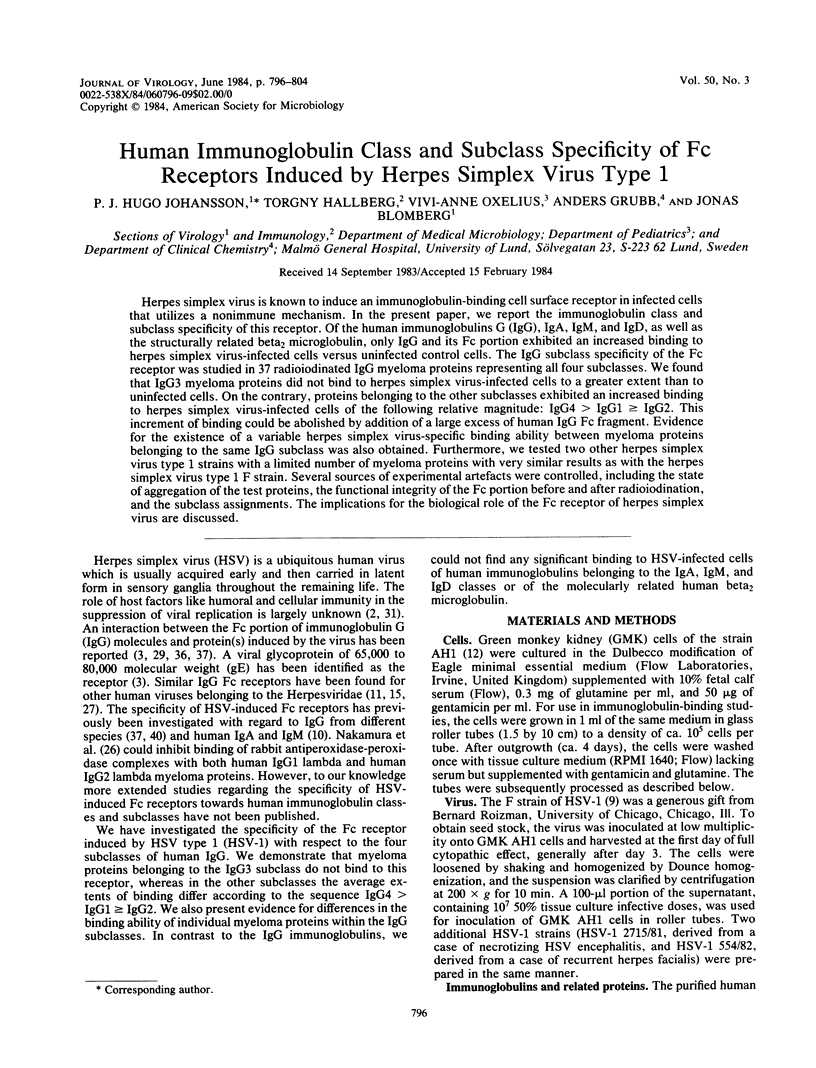
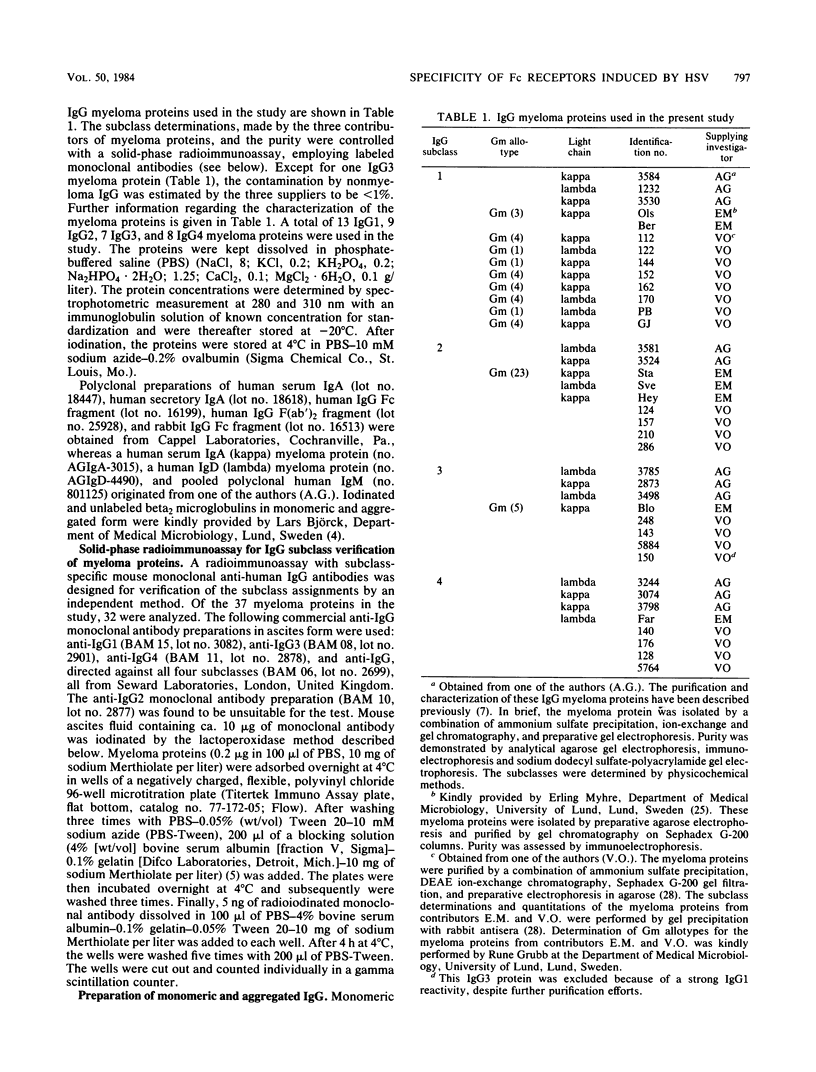
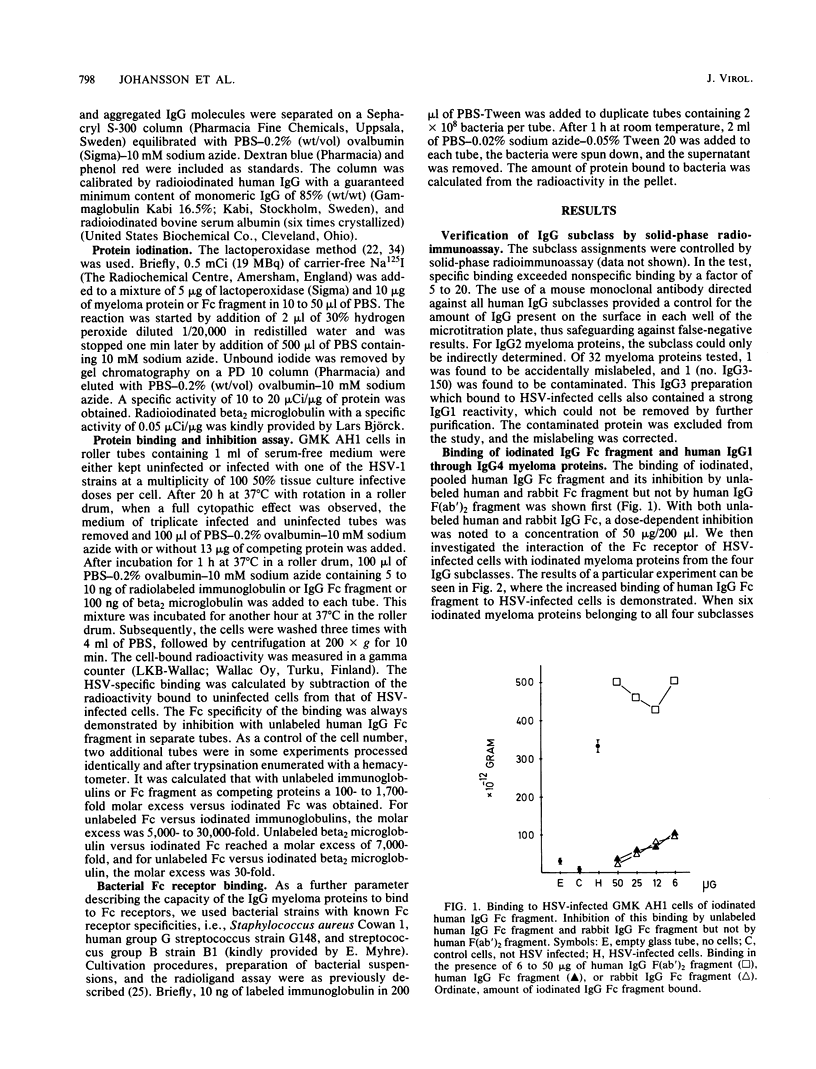
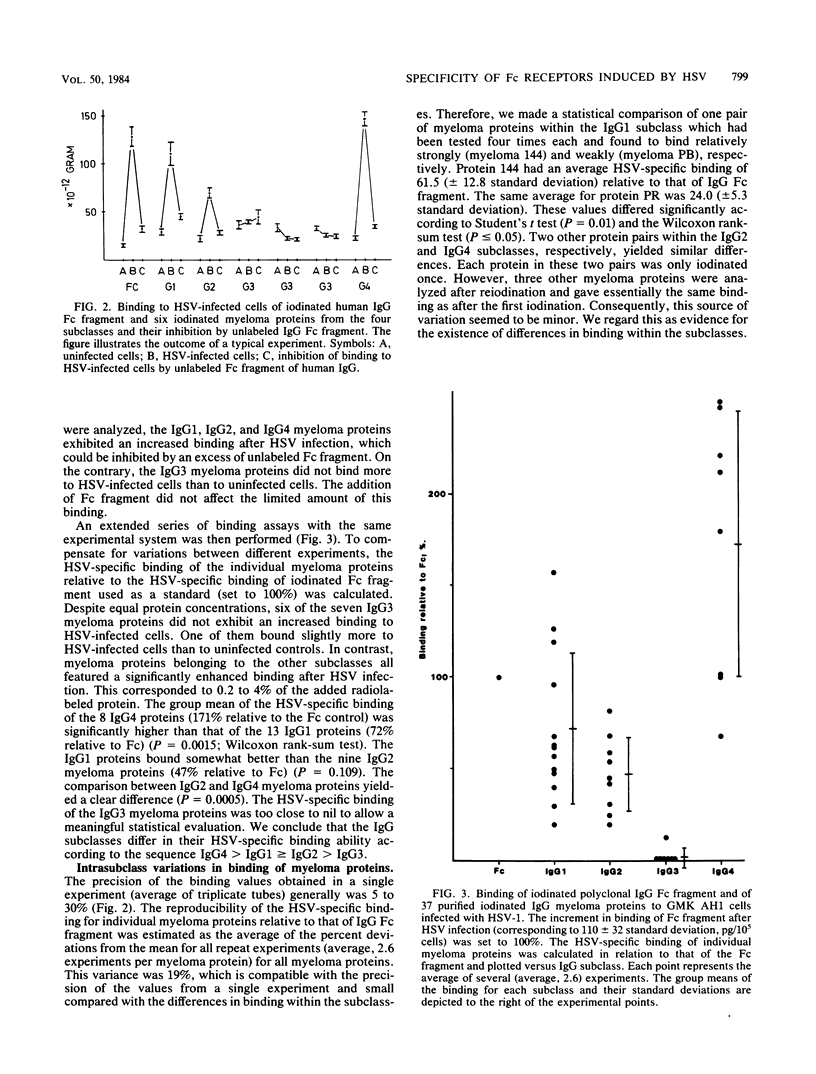
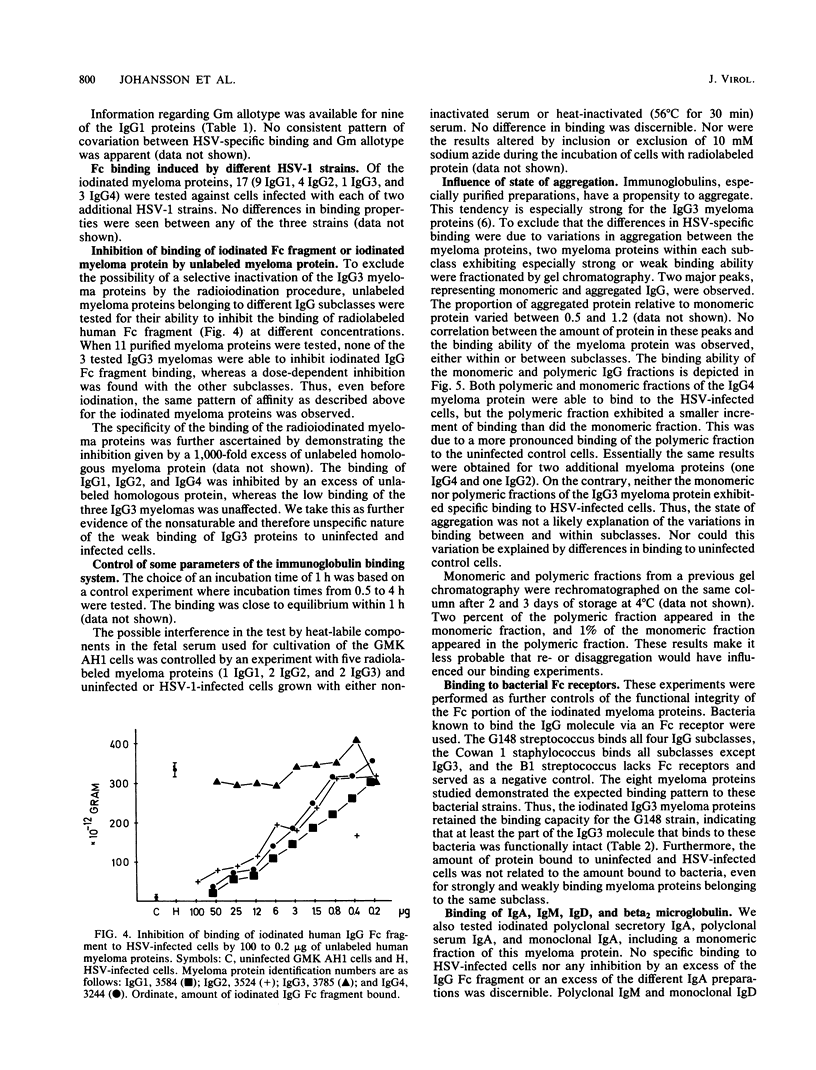
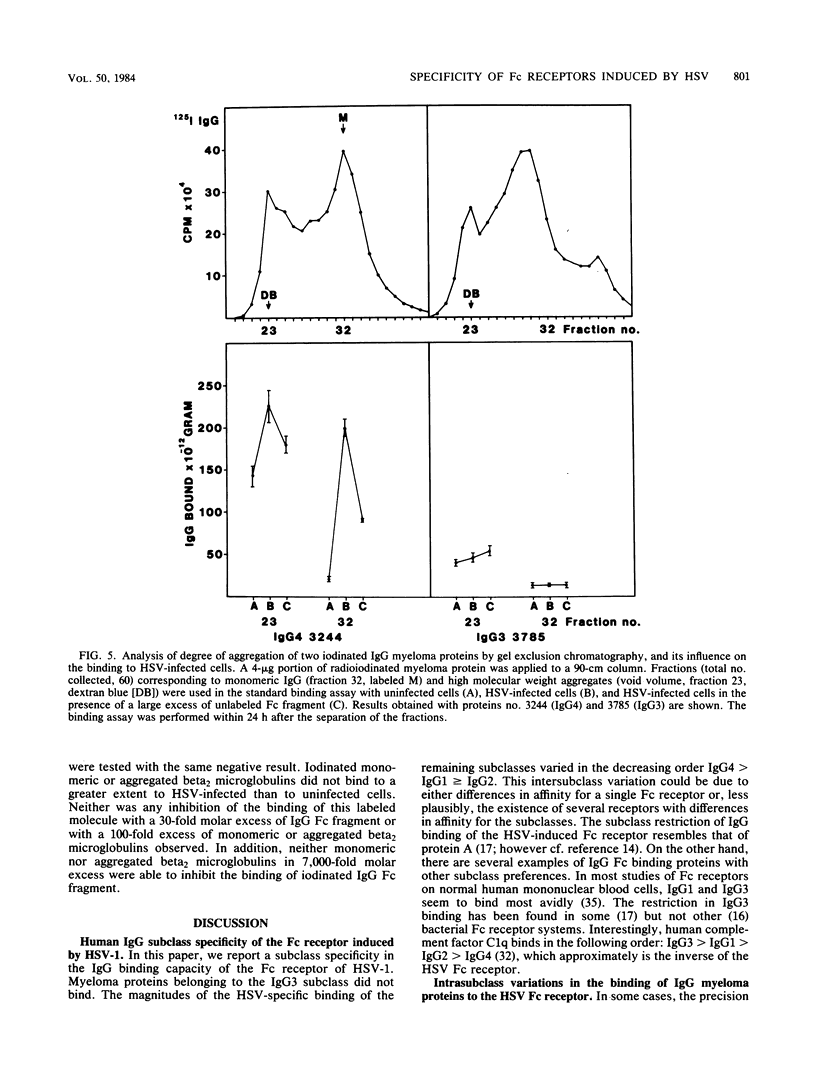
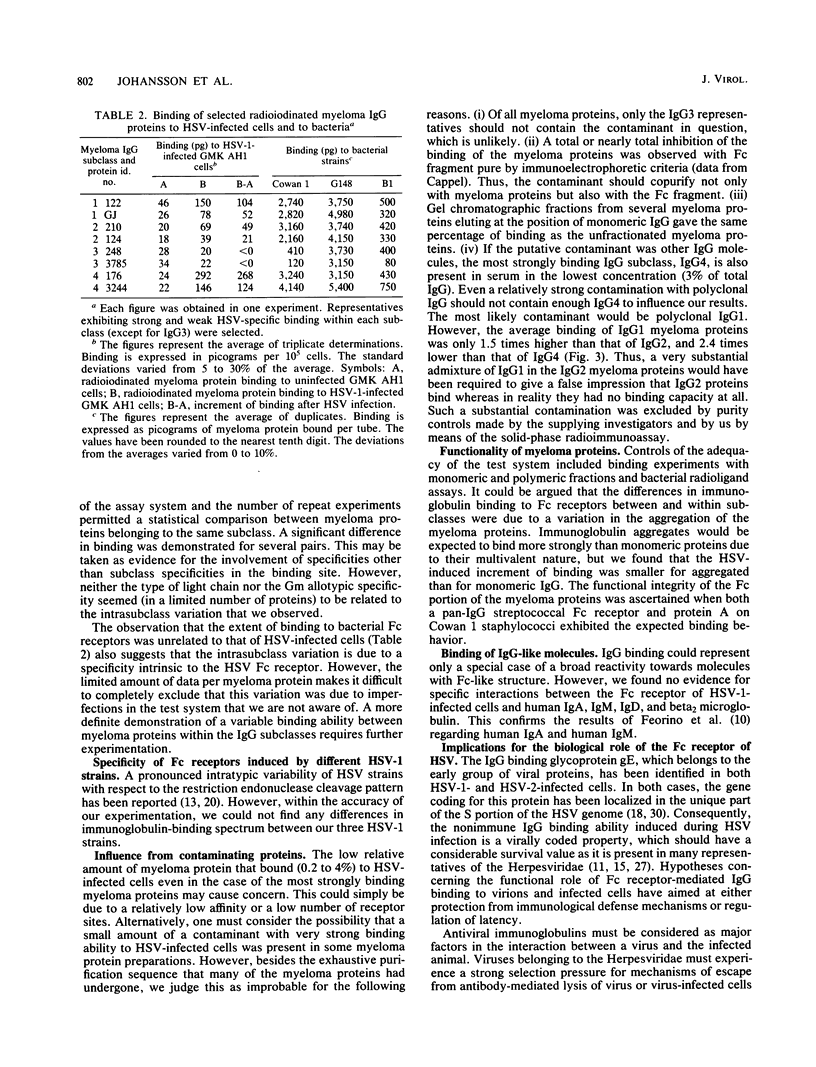

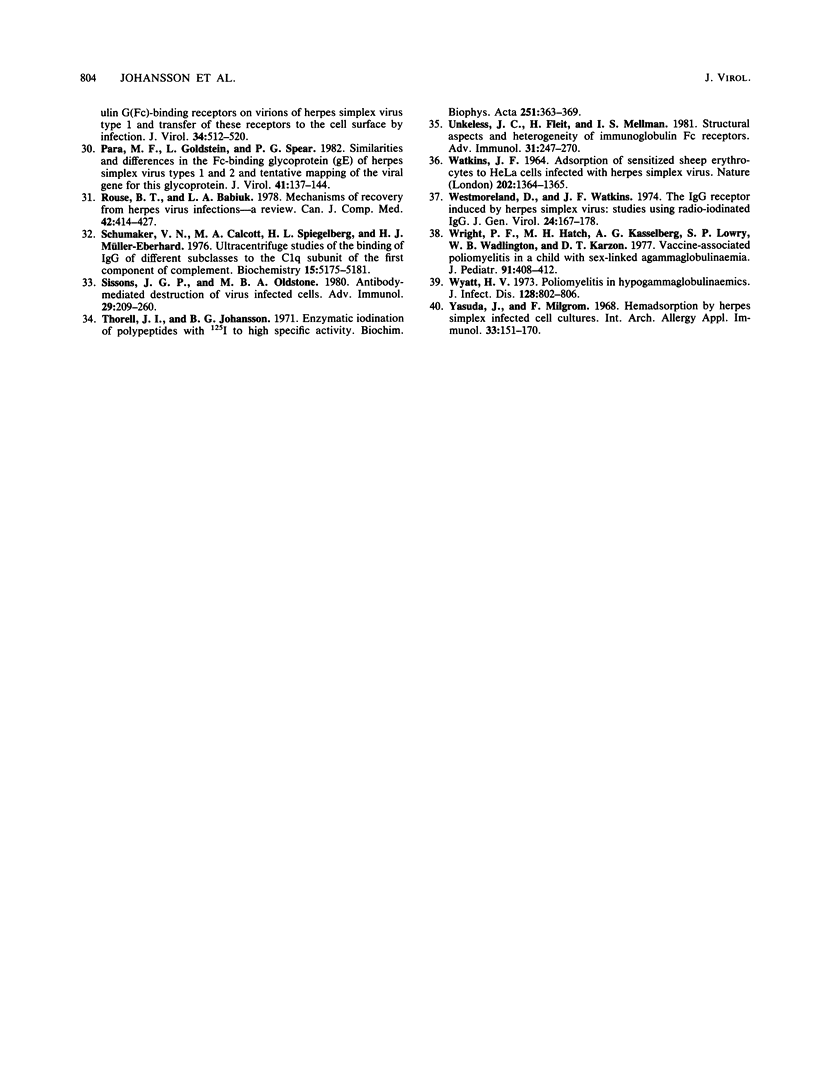
Selected References
These references are in PubMed. This may not be the complete list of references from this article.
- Adler R., Glorioso J. C., Cossman J., Levine M. Possible role of Fc receptors on cells infected and transformed by herpesvirus: escape from immune cytolysis. Infect Immun. 1978 Aug;21(2):442–447. doi: 10.1128/iai.21.2.442-447.1978. [DOI] [PMC free article] [PubMed] [Google Scholar]
- Babiuk L. A., Rouse B. T. Immune control of herpesvirus latency. Can J Microbiol. 1979 Mar;25(3):267–274. doi: 10.1139/m79-043. [DOI] [PubMed] [Google Scholar]
- Baucke R. B., Spear P. G. Membrane proteins specified by herpes simplex viruses. V. Identification of an Fc-binding glycoprotein. J Virol. 1979 Dec;32(3):779–789. doi: 10.1128/jvi.32.3.779-789.1979. [DOI] [PMC free article] [PubMed] [Google Scholar]
- Björck L., Tylewska S. K., Wadström T., Kronvall G. beta 2-Microglobulin is bound to streptococcal M protein. Scand J Immunol. 1981;13(4):391–394. doi: 10.1111/j.1365-3083.1981.tb00149.x. [DOI] [PubMed] [Google Scholar]
- Blomberg J., Nilsson I., Andersson M. Viral antibody screening system that uses a standardized single dilution immunoglobulin G enzyme immunoassay with multiple antigens. J Clin Microbiol. 1983 Jun;17(6):1081–1091. doi: 10.1128/jcm.17.6.1081-1091.1983. [DOI] [PMC free article] [PubMed] [Google Scholar]
- Capra J. D., Kunkel H. G. Aggregation of gamma-G3 proteins: relevance to the hyperviscosity syndrome. J Clin Invest. 1970 Mar;49(3):610–621. doi: 10.1172/JCI106272. [DOI] [PMC free article] [PubMed] [Google Scholar]
- Christensen P., Burova L. A., Grubb A., Grubb R., Samuelsson G., Schalén C., Svensson M. L. Interaction of the Fc part of IgG with Lancefield extracts of hemolytic streptococci. Strain specificity and activity. Acta Pathol Microbiol Scand C. 1979 Feb;87C(1):73–77. [PubMed] [Google Scholar]
- Costa J., Rabson A. S., Yee C., Tralka T. S. Immunoglobulin binding to herpes virus-induced Fc receptors inhibits virus growth. Nature. 1977 Sep 15;269(5625):251–252. doi: 10.1038/269251a0. [DOI] [PubMed] [Google Scholar]
- Ejercito P. M., Kieff E. D., Roizman B. Characterization of herpes simplex virus strains differing in their effects on social behaviour of infected cells. J Gen Virol. 1968 May;2(3):357–364. doi: 10.1099/0022-1317-2-3-357. [DOI] [PubMed] [Google Scholar]
- Feorino P. M., Shore S. L., Reimer C. B. Detection by indirect immunofluorescence of Fc receptors in cells acutely infected with Herpes simplex virus. Int Arch Allergy Appl Immunol. 1977;53(3):222–233. doi: 10.1159/000231756. [DOI] [PubMed] [Google Scholar]
- Furukawa T., Hornberger E., Sakuma S., Plotkin S. A. Demonstration of immunoglobulin G receptors induced by human cytomegalovirus. J Clin Microbiol. 1975 Oct;2(4):332–336. doi: 10.1128/jcm.2.4.332-336.1975. [DOI] [PMC free article] [PubMed] [Google Scholar]
- GUENALP A. GROWTH AND CYTOPATHIC EFFECT OF RUBELLA VIRUS IN A LINE OF GREEN MONKEY KIDNEY CELLS. Proc Soc Exp Biol Med. 1965 Jan;118:85–90. [PubMed] [Google Scholar]
- Hayward G. S., Frenkel N., Roizman B. Anatomy of herpes simplex virus DNA: strain differences and heterogeneity in the locations of restriction endonuclease cleavage sites. Proc Natl Acad Sci U S A. 1975 May;72(5):1768–1772. doi: 10.1073/pnas.72.5.1768. [DOI] [PMC free article] [PubMed] [Google Scholar]
- Inganäs M., Johansson S. G., Bennich H. H. Interaction of human polyclonal IgE and IgG from different species with protein A from Staphylococcus aureus: demonstration of protein-A-reactive sites located in the Fab'2 fragment of human IgG. Scand J Immunol. 1980;12(1):23–31. doi: 10.1111/j.1365-3083.1980.tb00037.x. [DOI] [PubMed] [Google Scholar]
- Keller R., Peitchel R., Goldman J. N., Goldman M. An IgG-Fc receptor induced in cytomegalovirus-infected human fibroblasts. J Immunol. 1976 Mar;116(3):772–777. [PubMed] [Google Scholar]
- Kronvall G. A surface component in group A, C, and G streptococci with non-immune reactivity for immunoglobulin G. J Immunol. 1973 Nov;111(5):1401–1406. [PubMed] [Google Scholar]
- Kronvall G., Williams R. C., Jr Differences in anti-protein A activity among IgG subgroups. J Immunol. 1969 Oct;103(4):828–833. [PubMed] [Google Scholar]
- Lee G. T., Para M. F., Spear P. G. Location of the structural genes for glycoproteins gD and gE and for other polypeptides in the S component of herpes simplex virus type 1 DNA. J Virol. 1982 Jul;43(1):41–49. doi: 10.1128/jvi.43.1.41-49.1982. [DOI] [PMC free article] [PubMed] [Google Scholar]
- Linde G. A., Hammarström L., Persson M. A., Smith C. I., Sundqvist V. A., Wahren B. Virus-specific antibody activity of different subclasses of immunoglobulins G and A in cytomegalovirus infections. Infect Immun. 1983 Oct;42(1):237–244. doi: 10.1128/iai.42.1.237-244.1983. [DOI] [PMC free article] [PubMed] [Google Scholar]
- Linnemann C. C., Jr, Buchman T. G., Light I. J., Ballard J. L. Transmission of herpes-simplex virus type 1 in a nursery for the newborn. Identification of viral isolates by D.N.A. "fingerprinting". Lancet. 1978 May 6;1(8071):964–966. doi: 10.1016/s0140-6736(78)90251-9. [DOI] [PubMed] [Google Scholar]
- Linnemann C. C., Jr, May D. B., Schubert W. K., Caraway C. T., Schiff G. M. Fatal viral encephalitis in children with X-linked hypogammaglobulinemia. Am J Dis Child. 1973 Jul;126(1):100–103. doi: 10.1001/archpedi.1973.02110190088019. [DOI] [PubMed] [Google Scholar]
- Marchalonis J. J. An enzymic method for the trace iodination of immunoglobulins and other proteins. Biochem J. 1969 Jun;113(2):299–305. doi: 10.1042/bj1130299. [DOI] [PMC free article] [PubMed] [Google Scholar]
- Mease P. J., Ochs H. D., Wedgwood R. J. Successful treatment of echovirus meningoencephalitis and myositis-fasciitis with intravenous immune globulin therapy in a patient with X-linked agammaglobulinemia. N Engl J Med. 1981 May 21;304(21):1278–1281. doi: 10.1056/NEJM198105213042107. [DOI] [PubMed] [Google Scholar]
- Myhre E. B., Kronvall G. Heterogeneity of nonimmune immunoglobulin Fc reactivity among gram-positive cocci: description of three major types of receptors for human immunoglobulin G. Infect Immun. 1977 Sep;17(3):475–482. doi: 10.1128/iai.17.3.475-482.1977. [DOI] [PMC free article] [PubMed] [Google Scholar]
- Nakamura Y., Costa J., Tralka T. S., Yee C. L., Rabson A. S. Properties of the cell surface Fc-receptor induced by herpes simplex virus. J Immunol. 1978 Sep;121(3):1128–1131. [PubMed] [Google Scholar]
- Ogata M., Shigeta S. Appearance of immunoglobulin G Fc receptor in cultured human cells infected with varicella-zoster virus. Infect Immun. 1979 Nov;26(2):770–774. doi: 10.1128/iai.26.2.770-774.1979. [DOI] [PMC free article] [PubMed] [Google Scholar]
- Oxelius V. A. Crossed immunoelectrophoresis and electroimmunoassay of human IgG subclasses. Acta Pathol Microbiol Scand C. 1978 Jun;86C(3):109–116. doi: 10.1111/j.1699-0463.1978.tb02567.x. [DOI] [PubMed] [Google Scholar]
- Para M. F., Goldstein L., Spear P. G. Similarities and differences in the Fc-binding glycoprotein (gE) of herpes simplex virus types 1 and 2 and tentative mapping of the viral gene for this glycoprotein. J Virol. 1982 Jan;41(1):137–144. doi: 10.1128/jvi.41.1.137-144.1982. [DOI] [PMC free article] [PubMed] [Google Scholar]
- Rouse B. T., Babiuk L. A. Mechanisms of recovery from Herpesvirus infections -a review. Can J Comp Med. 1978 Oct;42(4):414–427. [PMC free article] [PubMed] [Google Scholar]
- Schumaker V. N., Calcott M. A., Spiegelberg H. L., Müller-Eberhard H. J. Ultracentifuge studies of the binding of IgG of different subclasses to the Clq subunit of the first component of complement. Biochemistry. 1976 Nov 16;15(23):5175–5181. doi: 10.1021/bi00668a035. [DOI] [PubMed] [Google Scholar]
- Sissons J. G., Oldstone M. B. Antibody-mediated destruction of virus-infected cells. Adv Immunol. 1980;29:209–260. doi: 10.1016/S0065-2776(08)60045-0. [DOI] [PMC free article] [PubMed] [Google Scholar]
- Thorell J. I., Johansson B. G. Enzymatic iodination of polypeptides with 125I to high specific activity. Biochim Biophys Acta. 1971 Dec 28;251(3):363–369. doi: 10.1016/0005-2795(71)90123-1. [DOI] [PubMed] [Google Scholar]
- Unkeless J. C., Fleit H., Mellman I. S. Structural Aspects and Heterogeneity of Immunoglobulin Fc Receptors. Adv Immunol. 1981;31:247–270. doi: 10.1016/s0065-2776(08)60922-0. [DOI] [PubMed] [Google Scholar]
- WATKINS J. F. ADSORPTION OF SENSITIZED SHEEP ERYTHROCYTES TO HELA CELLS INFECTED WITH HERPES SIMPLEX VIRUS. Nature. 1964 Jun 27;202:1364–1365. doi: 10.1038/2021364a0. [DOI] [PubMed] [Google Scholar]
- Westmoreland D., Watkins J. F. The IgG receptor induced by herpes simplex virus: studies using radioiodinated IgG. J Gen Virol. 1974 Jul;24(1):167–178. doi: 10.1099/0022-1317-24-1-167. [DOI] [PubMed] [Google Scholar]
- Wright P. F., Hatch M. H., Kasselberg A. G., Lowry S. P., Wadlington W. B., Karzon D. T. Vaccine-associated poliomyelitis in a child with sex-linked agammaglobulinemia. J Pediatr. 1977 Sep;91(3):408–412. doi: 10.1016/s0022-3476(77)81309-7. [DOI] [PubMed] [Google Scholar]
- Wyatt H. V. Poliomyelitis in hypogammaglobulinemics. J Infect Dis. 1973 Dec;128(6):802–806. doi: 10.1093/infdis/128.6.802. [DOI] [PubMed] [Google Scholar]
- Yasuda J., Milgrom F. Hemadsorption by herpes simplex-infected cell cultures. Int Arch Allergy Appl Immunol. 1968;33(2):151–170. doi: 10.1159/000229985. [DOI] [PubMed] [Google Scholar]


